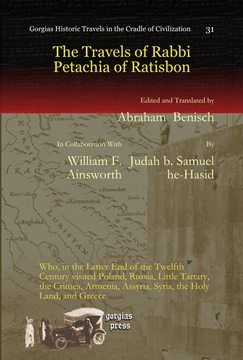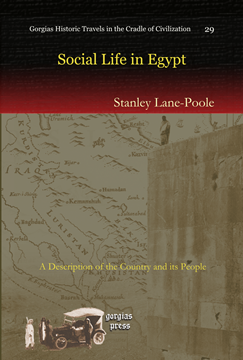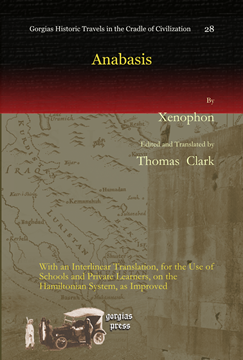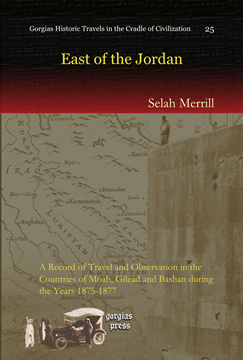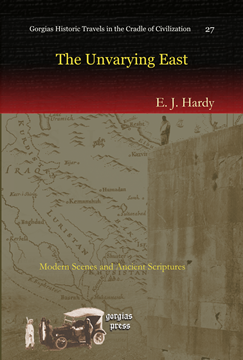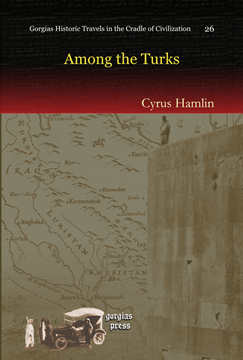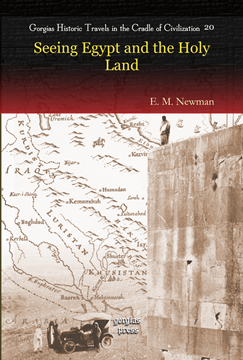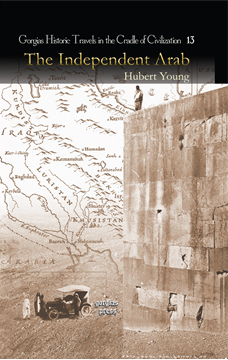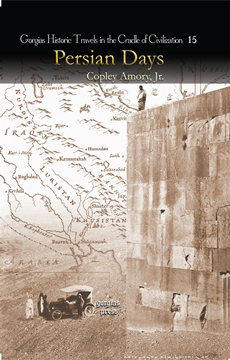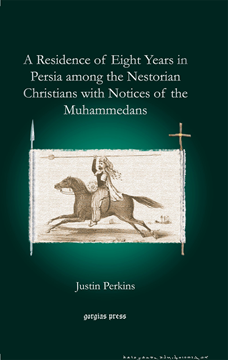Kiraz Historic Travels Archive
Kiraz Historic Travels Archive is a series of reprints of historic travelogues from travelers to regions of high antiquity: North Africa, Western and West-Central Asia. Glimpses into a forgotten world, these journals show us many of the roots of our own present-day civilization.
Missionary Life in Persia
Being glimpses at a quarter of a century of labors among the Nestorian Christians
By Justin Perkins; Introduction by John Pierre Ameer
Series: Kiraz Historic Travels Archive 32
ISBN: 978-1-4632-3921-3
An account by the American missionary, Justin Perkins, of his years living among the Christians of Persia, with a new Introduction by John Ameer, setting the activities and experiences of the American missionaries in Persia in their historical context.
$78.65 (USD) $47.19 (USD)
The Travels of Rabbi Petachia of Ratisbon
Who, in the Latter End of the Twelfth Century visited Poland, Russia, Little Tartary, the Crimea, Armenia, Assyria, Syria, the Holy Land, and Greece.
Edited and Translated by Abraham Benisch; In Collaboration With William F. Ainsworth; By Judah b. Samuel he-Hasid
Series: Kiraz Historic Travels Archive 31
ISBN: 978-1-61143-911-3
This text narrates the travels of Rabbi Petachia, a medieval rabbi from Regensburg, Germany, who set out to visit Baghdad, Susa, and Palestine.
$153.00 (USD) $91.80 (USD)
Social Life in Egypt
A Description of the Country and its People
Series: Kiraz Historic Travels Archive 29
ISBN: 978-1-61719-343-9
A survey of Egypt by the distinguished English student of Arabic. Six steel engravings, and over a hundred wood-cuts are used to illustrate Egyptian culture, society and inhabitants shortly after the English conquest.
$123.00 (USD) $73.80 (USD)
Anabasis
With an Interlinear Translation, for the Use of Schools and Private Learners, on the Hamiltonian System, as Improved
By Xenophon; Edited and Translated by Thomas Clark
Series: Kiraz Historic Travels Archive 28
ISBN: 978-1-61719-226-5
Xenophon's Journey Upcountry, with interlinear translation.
$225.00 (USD) $135.00 (USD)
East of the Jordan
A Record of Travel and Observation in the Countries of Moab, Gilead and Bashan during the Years 1875-1877
Series: Kiraz Historic Travels Archive 25
ISBN: 978-1-60724-316-8
In the early years of archaeological excitement in the environment of the biblical world, Merrill traveled through what is today Jordan on an extended journey and wrote this engaging account of his travels and explorations. Copiously illustrated with line drawings and etchings of the monuments and notable sights he encountered, his descriptions still retain their compelling voice. An historical account of travels around an area that would soon blossom into an archaeological haven, this journal is worth exploration for its contribution to a new discipline.
$224.00 (USD) $134.40 (USD)
A Brief Pilgrimage in the Holy Land
Series: Kiraz Historic Travels Archive 23
ISBN: 978-1-60724-270-3
This series of addresses constitute a unique travelogue from a renowned author and traveler Caroline Hazard. In addition to her ability as a travel writer, Hazard was also an artist and poet. Her talents in this regard are clear to readers of this little book. Paintings and photographs from her journey to the Holy Land are interspersed with her account of her travels and sonnets that provide the ambiance of the experience for her readers. Unconventional as a travel journal in its anecdotal narration of her impressions, the overall feel of the book is an experience for any armchair adventurer.
$127.00 (USD) $76.20 (USD)
Mount Sinai
A Modern Pilgrimage
Series: Kiraz Historic Travels Archive 22
ISBN: 978-1-60724-243-7
This timeless travelogue by noted hymnographer and missionary A. Mary R. Dobson recounts her journey to the manuscript-rich monastery of St. Catherine’s in the Sinai peninsula. Traveling with her cousin, Orientatlist Rendel Harris, Dobson wrote an account of her journey that still captures the imagination of modern day readers.
$124.00 (USD) $74.40 (USD)
The Unvarying East
Modern Scenes and Ancient Scriptures
By E. J. Hardy
Series: Kiraz Historic Travels Archive 27
ISBN: 978-1-60724-318-2
E. J. Hardy traveled widely and emerged as a skilled writer. This account of the Holy Land, written by a clergyman, is an effort to provide a touchstone for modern readers who are interested in the biblical story. Beginning almost as a gazetteer, Hardy describes the agriculture and fauna of the Palestine of his day. A distinctive travelogue, this account of the Holy Land will appeal to a wide range of readers.
$178.00 (USD) $106.80 (USD)
Among the Turks
By Cyrus Hamlin
Series: Kiraz Historic Travels Archive 26
ISBN: 978-1-60724-317-5
Part travelogue, part missionary account, this book recounts the experiences of a nineteenth-century traveler in the Ottoman Empire. Indeed, Hamlin’s account begins with a description of the origin and extent of the Ottoman Empire, including a consideration of the social issues it faced. An encounter with Islam, with a sympathetic reading of the Quran, leads Hamlin to conclude with the misrepresentation of the Ottomans that he has discovered to be problematic. An intimate glimpse into the Ottoman world of the nineteenth century, this historic travelogue will be welcomed by students of missionary activity and the rapidly changing region of Turkey.
$177.00 (USD) $106.20 (USD)
Geography Toward History
Studies in the Mediterranean Basin, Mesopotamia and Central Asia
By Ellsworth Huntington; Introduction by Barry Vann
Series: Kiraz Historic Travels Archive 1
ISBN: 978-1-59333-861-9
This work compiles essays by Dr. Huntington concerning the usefulness of geography and climatology for understanding history and projecting environmental outcomes. It is of value to students of geography, climatology and Mediterranean, the Near Eastern and Central Asian history.
$183.00 (USD) $109.80 (USD)
Seeing Egypt and the Holy Land
By E. M. Newman
Series: Kiraz Historic Travels Archive 20
ISBN: 978-1-59333-911-1
With the characteristic compelling photographs that accompany his work, E. M. Newman here presents his unique outlook on Egypt and the Holy Land. Written with the competence of a professional travel writer, Newman takes the reader through his arrival in Egypt by ship and on a virtual tour of the noted wonders of that land. His impressions of Egypt, Palestine, the Arabian Desert and Sinai are all dutifully recorded. Finishing up with the accounts of his main New Testament sites, Nazareth, the Jordan River, Bethlehem, and Jerusalem, this travelogue contains a wealth of impressions and memories. Illustrated with over 300 photographs, this volume gives a visually descriptive tour of these ancient lands.
$185.00 (USD) $111.00 (USD)
My Winter on the Nile
Series: Kiraz Historic Travels Archive 16
ISBN: 978-1-59333-723-0
From the eyes of a novelist, Warner illustrates the drama and romance of a voyage through Egypt. Particularly attracted to the Muslim life and practice in Egypt, and the monuments of the ancient empires, Warner takes the reader through the length of the country into Ethiopia and tropical Africa. A travelogue that captures the 19th century fascination with the East, this volume will delight anyone interested in Egypt.
$205.00 (USD) $123.00 (USD)
Akbar and the Jesuits
An Account of the Jesuit Missions to the Court of Akbar
Series: Kiraz Historic Travels Archive 7
ISBN: 978-1-59333-630-1
The narrative of the Jesuit missions to Akbar, ruler of the Mughal Empire in India, is a noted period piece in travel writing. Although the author never traveled abroad, he compiled a substantial history of Jesuit missionary activity. This book narrates the missions to India in the 16th and 17th centuries.
$170.00 (USD) $102.00 (USD)
Palestine Past and Present
With Biblical, Literary, and Scientific Notices
Series: Kiraz Historic Travels Archive 9
ISBN: 978-1-59333-570-0
A nineteenth-century travelogue in a class by itself, Osborn’s account of his travels through the Holy Land is sprinkled with literary, biblical, and scientific observations. This work on the physical geography of the Holy Land remains undiminished despite the years since its publication.
$232.00 (USD) $139.20 (USD)
Through Persia on a Side-Saddle
Series: Kiraz Historic Travels Archive 14
ISBN: 978-1-59333-558-8
This written travelogue of Ella Sykes’ historic first journey across central Asia has been considered a classic of women’s studies as well as a historic travel account. Detailing the impressions of Sykes while traveling with her diplomat brother through central Asia in the nineteenth century, this illustrated volume has a wide appeal to those interested in Iran as it used to be.
$167.00 (USD) $100.20 (USD)
Early Travels in Palestine
Series: Kiraz Historic Travels Archive 21
ISBN: 978-1-59333-528-1
This delightful collection of travelogues from the years c. 700 – 1697 catalogues the views of European travelers and pilgrims in the Middle Ages. Wright includes a series of brief accounts from early in this period from Bishop Arculf, Willibald, and Bernard the Wise. Narratives of Saewulf, Sigurd the Crusader, and Rabbi Benjamin of Tudela give the outlook of Christian and Jewish travelers. The work concludes with the lengthier accounts of Sir John Maundeville, Bertandon de le Brocquière, and Henry Maundrell.
$218.00 (USD) $130.80 (USD)
The Independent Arab
By Hubert Young
Series: Kiraz Historic Travels Archive 13
ISBN: 978-1-59333-672-1
Part travelogue and part memoir, this account of Major Sir Hubert Young’s time spent in the Middle East in diplomatic and military roles provides a rare insider’s look at political developments in that part of the world. Sympathetic with the rich Arabic heritage of Mesopotamia, Arabia, and what is now Jordan and Syria, Young writes a lucid narrative spanning the time from his first involvement up to the Iraqi Mandate.
$172.00 (USD) $103.20 (USD)
Travels in Turkey, Asia-Minor, Syria, and Across the Desert into Egypt
During the Years 1799, 1800, and 1801 in Company with the Turkish Army and the British Military Mission
Series: Kiraz Historic Travels Archive 17
ISBN: 978-1-59333-724-7
A historic travelogue with an eye toward the medical conditions encountered along the way, this rare book sheds light on western Asia from a unique vantage-point. Wittman describes his journey through Turkey, Syria, Palestine, and Egypt, noting along the way the diseases suffered by the residents, and brings the world of ancient western Asia to life through his vivid writing.
$251.00 (USD) $150.60 (USD)
Lawrence and the Arabian Adventure
Series: Kiraz Historic Travels Archive 4
ISBN: 978-1-59333-562-5
A sanctioned biography of T. E. Lawrence, known popularly as “Lawrence of Arabia,” this work by the eminent Robert Graves attempts to provide a fair and balanced treatment of the man. Based on interviews with Lawrence and his close associates, this account clearly displays its authenticity.
$196.00 (USD) $117.60 (USD)
Travels and Adventures 1435-1439
Series: Kiraz Historic Travels Archive 8
ISBN: 978-1-59333-578-6
The remarkable narrative of the Medieval traveler Pero Tafur comes from a single manuscript written before the printing press was invented. Letts presents the journeys of Tafur through Europe and the Holy Land during the years 1435-1439 when the voyager was in his mid-twenties. A wealth of information about pre-modern Europe and Palestine await the reader of this account.
$154.00 (USD) $92.40 (USD)
Persian Days
By Copley Amory
Series: Kiraz Historic Travels Archive 15
ISBN: 978-1-59333-608-0
A fascinating travelogue through southern and central Iran, this early nineteenth-century account is written with wit and insight; the polymathic Copley Amory Jr. proves an able tour guide. The reader is taken from Tehran to Kerman and back, along a trail that highlights ancient sites of historical importance. Along the way, the culture of “tribes and tents” is described, as well as a plucky misadventure involving encounters with camel caravans and excessive automobile troubles. Written in a witty and engaging style, this account of a classic journey contains an education in the history and customs of a vanishing way of life.
$161.00 (USD) $96.60 (USD)
Winters in Algeria
Series: Kiraz Historic Travels Archive 2
ISBN: 978-1-59333-599-1
In the 1870s, American painter Frederick Bridgman traveled from his home in Paris to Algiers. Although he traveled to paint, his journeys so impressed him that he produced a written account that appeared in “Harpers Monthly.” That account became the basis of this book. His travelogue describes the people and customs, the layout of the towns, the celebration of the Muslim religion, the black community in an Islamic context, and the legends of the people of historic Algeria.
$150.00 (USD) $90.00 (USD)
Adventures in Arabia
Among the Bedouins, Druses, Whirling Dervishes, and Yezidee Devil Worshipers
Series: Kiraz Historic Travels Archive 11
ISBN: 978-1-59333-597-7
In this personal travelogue, William Seabrook chronicles his adventures in the Middle East in the early part of the twentieth century. Specifically he focuses on his time among four Arabic groups: the Bedouins, Druses, Dervishes, and Yezidees.
$178.00 (USD) $106.80 (USD)
A Residence of Eight Years in Persia among the Nestorian Christians with Notices of the Muhammedans
Series: Kiraz Historic Travels Archive 30
ISBN: 1-59333-410-9
Gives a travelogue and a journal of his missionary activities in the Middle East between 1834 and 1841, primarily with the Church of the East.
$228.00 (USD) $136.80 (USD)


